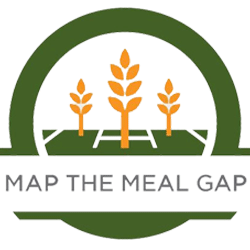Map the Meal Gap
In order to address food insecurity, we must first understand it. Every year, Feeding America conducts the Map the Meal Gap (MMG) study to learn more about food insecurity at the local level. By intentionally focusing on people most impacted, we can ensure everyone thrives.
To accurately estimate the number of people who may be food insecure in every U.S. county and congressional district, Map the Meal Gap uses publicly available state and local data from the U.S. Census Bureau and Bureau of Labor Statistics on factors that research has shown to contribute to food insecurity. These factors include unemployment and poverty, as well as other demographic and household characteristics. Along with estimates of food insecurity for the overall population and for children, the study also includes local food insecurity estimates for select income levels, ages, and races/ethnicities. In addition to food insecurity, the study estimates the cost of a meal and the amount of need among people who are food insecure, using local data from NielsenIQ and national survey data from the U.S. Census Bureau.

Click the “Map The Meal Gap” logo above to access the latest MMG data about the East Texas Food Bank.